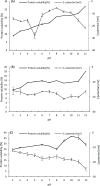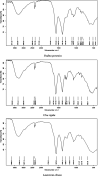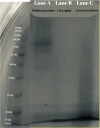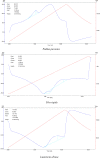Characterization of Proteins Extracted from Ulva sp., Padina sp., and Laurencia sp. Macroalgae Using Green Technology: Effect of In Vitro Digestion on Antioxidant and ACE-I Inhibitory Activity
- PMID: 38162757
- PMCID: PMC10753567
- DOI: 10.1021/acsomega.3c05041
Characterization of Proteins Extracted from Ulva sp., Padina sp., and Laurencia sp. Macroalgae Using Green Technology: Effect of In Vitro Digestion on Antioxidant and ACE-I Inhibitory Activity
Erratum in
-
Correction to "Characterization of Proteins Extracted from Ulva sp., Padina sp., and Laurencia sp. Macroalgae Using Green Technology: Effect of In Vitro Digestion on Antioxidant and ACE-I Inhibitory Activity".ACS Omega. 2024 Feb 16;9(8):9848. doi: 10.1021/acsomega.4c00407. eCollection 2024 Feb 27. ACS Omega. 2024. PMID: 38434875 Free PMC article.
Abstract
Macroalgal proteins were extracted from Ulva rigida (URPE) (green), Padina pavonica (PPPE) (brown), and Laurencia obtusa (LOPE) (red) using ultrasound-assisted enzymatic extraction, which is one of the green extraction technologies. Techno-functional, characteristic, and digestibility properties, and biological activities including antioxidant (AOA) and angiotensin-I converting enzyme (ACE-I) inhibitory activities were also investigated. According to the results, the extraction yield (EY) (94.74%) was detected in the extraction of L. obtusa, followed by U. rigida and P. pavonica. PPPE showed the highest ACE-I inhibitory activity before in vitro digestion. In contrast to PPPE, LOPE (20.90 ± 0.00%) and URPE (20.20 ± 0.00%) showed higher ACE-I inhibitory activity after in vitro digestion. The highest total phenolic content (TPC) (77.86 ± 1.00 mg GAE/g) was determined in LOPE. On the other hand, the highest AOACUPRAC (74.69 ± 1.78 mg TE/g) and AOAABTS (251.29 ± 5.0 mg TE/g) were detected in PPPE. After in vitro digestion, LOPE had the highest TPC (22.11 ± 2.18 mg GAE/g), AOACUPRAC (8.41 ± 0.06 mg TE/g), and AOAABTS (88.32 ± 0.65 mg TE/g) (p < 0.05). In vitro protein digestibility of three macroalgal protein extracts ranged from 84.35 ± 2.01% to 94.09 ± 0.00% (p < 0.05). Three macroalgae showed high oil holding capacity (OHC), especially PPPE (410.13 ± 16.37%) (p < 0.05), but they showed minimum foaming and emulsifying properties. The quality of the extracted macroalgal proteins was assessed using FTIR, SDS-PAGE, and DSC analyses. According to our findings, the method applied for macroalgal protein extraction could have a potential the promise of ultrasonication application as an environmentally friendly technology for food industry. Moreover, URPE, PPPE, and LOPE from sustainable sources may be attractive in terms of nourishment for people because of their digestibility, antioxidant properties, and ACE-I inhibitory activities.
© 2023 The Authors. Published by American Chemical Society.
Conflict of interest statement
The authors declare no competing financial interest.
Figures




Similar articles
-
Correction to "Characterization of Proteins Extracted from Ulva sp., Padina sp., and Laurencia sp. Macroalgae Using Green Technology: Effect of In Vitro Digestion on Antioxidant and ACE-I Inhibitory Activity".ACS Omega. 2024 Feb 16;9(8):9848. doi: 10.1021/acsomega.4c00407. eCollection 2024 Feb 27. ACS Omega. 2024. PMID: 38434875 Free PMC article.
-
Ultrasonic-Assisted Extraction and Antioxidant Potential of Valuable Protein from Ulva rigida Macroalgae.Life (Basel). 2022 Dec 28;13(1):86. doi: 10.3390/life13010086. Life (Basel). 2022. PMID: 36676035 Free PMC article.
-
Nutritional and Functional Bioactivity Value of Selected Azorean Macroalgae: Ulva compressa, Ulva rigida, Gelidium microdon, and Pterocladiella capillacea.J Food Sci. 2017 Jul;82(7):1757-1764. doi: 10.1111/1750-3841.13778. Epub 2017 Jun 16. J Food Sci. 2017. PMID: 28621445
-
Macroalgal Proteins: A Review.Foods. 2022 Feb 16;11(4):571. doi: 10.3390/foods11040571. Foods. 2022. PMID: 35206049 Free PMC article. Review.
-
Which Extraction Solvents and Methods Are More Effective in Terms of Chemical Composition and Biological Activity of Alceafasciculiflora from Turkey?Molecules. 2022 Aug 6;27(15):5011. doi: 10.3390/molecules27155011. Molecules. 2022. PMID: 35956963 Free PMC article. Review.
References
-
- FAOHow to Feed the World in 2050. In Executive Summary-Proceedings of the Expert Meeting on How to Feed the World in 2050, Food and Agriculture Organization: Rome, Italy, 2018.
-
- Rana V. S.; Sharma S.; Rana N.; Sharma U. Sustainable production through biostimulants under fruit orchards. CABI Agric. Biosci. 2022, 3 (1), 1–25. 10.1186/s43170-022-00102-w. - DOI
-
- FAO, IFAD, UNICEF, WFP & WHO . The State of Food Security and Nutrition in the World 2018. Building Climate Resilience for Food Security and Nutrition; FAO: Rome, 2018, Retrieved from http://www.fao.org/3/i9553en.pdf.
-
- Ummat V.; Sivagnanam S. P.; Rajauria G.; O’Donnell C.; Tiwari B. K. Advances in pre-treatment techniques and green extraction technologies for bioactives from seaweeds. Trends Food Sci. Technol. 2021, 110, 90–106. 10.1016/j.tifs.2021.01.018. - DOI
LinkOut - more resources
Full Text Sources
Miscellaneous

